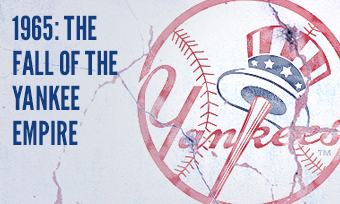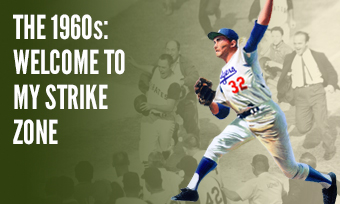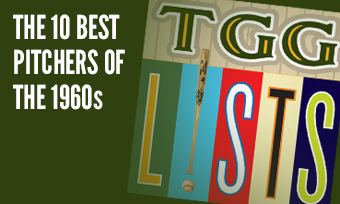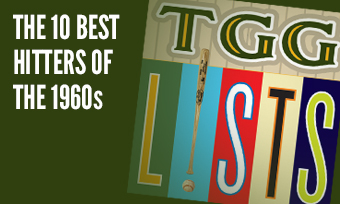The Yearly Reader
Leaders and Honors, 1965
Our list of baseball’s top 10 hitters and pitchers in both the American League and National League for the 1965 baseball season, as well as the awards and honors given to the game’s top achievers of the year.
The National League’s Top 10 Hitters, 1965
Bold type in brick red indicates league leader.
1. Willie Mays, San Francisco
Key Numbers: .317 average, 118 runs, 177 hits, 52 home runs, 112 RBIs, 76 walks, .398 on-base percentage, .645 slugging percentage.
For Mays, it all seemed to be about the home run; among his career-high 52 blasts was his 500th lifetime homer and 17 in one month (August) for a then-NL record.
2. Billy Williams, Chicago
Key Numbers: 164 games, .315 average, 115 runs, 203 hits, 39 doubles, 6 triples, 34 home runs, 108 RBIs, 10 stolen bases.
Though he would have more awe-inspiring numbers down the line, Williams continued to be at his most complete in 1965—hitting over .300 and collecting 200-plus hits and 10 steals for the second straight year.
3. Frank Robinson, Cincinnati
Key Numbers: .296 average, 109 runs, 172 hits, 33 doubles, 5 triples, 33 home runs, 113 RBIs, 18 intentional walks, 18 hit-by-pitches, 13 stolen bases.
We should have all been happy to play like an “old 30,” as the Reds claimed Robinson was before sending him off to Baltimore, given the exceptional output he produced in his last season at Cincinnati.
4. Hank Aaron, Milwaukee
Key Numbers: .318 average, 109 runs, 181 hits, 40 doubles, 32 home runs, 89 RBIs, 24 stolen bases.
Aaron’s 32 home runs led a sextet of Braves players who hit 20 or more, a then-NL record.
5. Deron Johnson, Cincinnati
Key Numbers: .287 average, 92 runs, 177 hits, 30 doubles, 7 triples, 32 home runs, 130 RBIs, 10 sacrifice flies.
Johnson was a surprise among the usual suspects (Frank Robinson, Vada Pinson, Pete Rose) in a Red-hot Cincinnati lineup. He never knocked in 100 runs—never mind 130—in any of 15 other seasons.
6. Pete Rose, Cincinnati
Key Numbers: .312 average, 670 at-bats, 117 runs, 209 hits, 35 doubles, 11 triples, 11 home runs, 81 RBIs.
Charlie Hustle had his first of 10 200-hit seasons and his first of 10 five-hit games.
7. Willie McCovey, San Francisco
Key Numbers: .276 average, 93 runs, 39 home runs, 92 RBIs, 88 walks.
It appeared that Stretch finally won the Cold War between himself and the injured Orlando Cepeda for the job of Giants first baseman; Cepeda would be dealt away to St. Louis the following year.
8. Ron Santo, Chicago
Key Numbers: 164 games, .285 average, 88 runs, 173 hits, 30 doubles, 33 home runs, 101 RBIs, 88 walks.
For Santo, the Wrigley sunshine must have been the ultimate replacement for Vitamin D as both he and Billy Williams co-led the majors with 164 games played—and played well, we might add.
9. Vada Pinson, Cincinnati
Key Numbers: .305 average, 669 at-bats, 97 runs, 204 hits, 34 doubles, 10 triples, 22 home runs, 94 RBIs, 21 stolen bases.
Pinson hit safely in his last 27 games, officially tying him with Edd Roush (in 1920 and 1924) for the longest streak in Reds history; he would add four more games to start 1966 and make it 31.
10. Richie Allen, Philadelphia
Key Numbers: .302 average, 93 runs, 187 hits, 31 doubles, 14 triples, 20 home runs, 85 RBIs, 74 walks, 15 stolen bases, 150 strikeouts.
It’s interesting to note: Allen was leading the NL in hitting (at .335) on July 3—the night he engaged in a pregame fight with veteran teammate Frank Thomas over a racist comment; he batted .276 the rest of the season as Phillies fans channeled their anger upon Allen after Thomas’ release from the club.
The American League’s Top 10 Hitters, 1965
1. Tony Oliva, Minnesota
Key Numbers: .321 average, 107 runs, 185 hits, 40 doubles, 5 triples, 16 home runs, 98 RBIs, 19 stolen bases, 10 sacrifice flies.
No American League player had won back-to-back batting titles to start a career—until Oliva.
2. Zoilo Versalles, Minnesota
Key Numbers: .273 average, 666 at-bats, 126 runs, 182 hits, 45 doubles, 12 triples, 19 home runs, 77 RBIs, 27 stolen bases, 122 strikeouts.
Versalles’ one-year wonder of a season—he had worthy numbers in other campaigns, but nothing like this—signaled the end of an era for an influx of Cuban ballplayers, shut off by Fidel Castro’s communist regime. Electric down the stretch, Versalles hit .346 with 23 doubles, 52 runs and 13 steals over his final 59 games.
3. Carl Yastrzemski, Boston
Key Numbers: 133 games, .312 average, 78 runs, 45 doubles, 3 triples, 20 home runs, 72 RBIs, 70 walks, .395 on-base percentage, .536 slugging percentage.
A gradually improving Yaz was one of the precious few bright spots on a Red Sox team that lost 100 games and drew a scant 652,000 to Fenway Park.
4. Leon Wagner, Cleveland
Key Numbers: .294 average, 91 runs, 28 home runs, 79 RBIs, 12 stolen bases.
The veteran outfielder’s power remained consistent from years past but, curiously, Wagner found the discipline to put more balls in play—as evidenced in his strikeout totals being more than halved, from 121 to 52.
5. Rocky Colavito, Cleveland
Key Numbers: 162 games, .287 average, 92 runs, 170 hits, 25 doubles, 26 home runs, 108 RBIs, 93 walks.
All was well again in Cleveland with the return of the popular Colavito after a five-year absence. That price of feeling good cost the Indians Tommy John, whom went to Chicago in the three-team trade that brought Colavito back to Cleveland.
6. Norm Cash, Detroit
Key Numbers: .266 average, 79 runs, 30 home runs, 83 RBIs, 77 walks.
After a tepid (.199 average, four homers) first 58 games, Cash cashed in on a strong second half, slugging 26 homers on a .302 figure.
7. Tom Tresh, New York
Key Numbers: .279 average, 94 runs, 29 doubles, 6 triples, 26 home runs, 74 RBIs.
Goodness knows how much worse the Yankees’ 1965 collapse would have been had it not been for Tresh, one of the few team members who didn’t underperform or get banged up.
8. Harmon Killebrew, Minnesota
Key Numbers: 113 games, .269 average, 78 runs, 25 home runs, 75 RBIs, 72 walks.
If not for a seven-week stay on the disabled list due to an elbow injury, Killer would have likely nailed down his fourth straight AL home run crown.
9. Jimmie Hall, Minnesota
Key Numbers: .285 average, 81 runs, 25 doubles, 20 home runs, 86 RBIs, 14 stolen bases.
If the hitting of Oliva, the power of Killebrew and the breakout tenacity of Versalles wasn’t enough for opposing pitchers, they also had to deal with Hall, who quietly put together strong supporting numbers for the AL champion Twins.
10. Tony Conigliaro, Boston
Key Numbers: .269 average, 82 runs, 21 doubles, 5 triples, 32 home runs, 82 RBIs.
The 20-year-old Conigliaro became the youngest American Leaguer to lead the junior circuit in home runs.
The National League’s Top 10 Pitchers, 1965
1. Sandy Koufax, Los Angeles
Key Numbers: 2.04 ERA, 26 wins, 8 losses, .765 win percentage, 2 saves, 43 appearances, 41 starts, 27 complete games, 8 shutouts, 335.2 innings, 71 walks, 382 strikeouts, 11 wild pitches.
In the emerging era of great pitching, it was becoming crystal clear that Sandy Koufax reigned as the king of kings on the mound. While he struck out 10 or more batters 21 times in his (then) record-setting year for K’s, he never struck out more than 14 any one of them.
2. Juan Marichal, San Francisco
Key Numbers: 2.13 ERA, 22 wins, 13 losses, 37 starts, 24 complete games, 10 shutouts, 295.1 innings, 46 walks.
Marichal’s stellar ERA and 10 shutouts weren’t enough to overcome the notoriety of bashing Johnny Roseboro’s head with a bat.
3. Jim Bunning, Philadelphia
Key Numbers: 2.60 ERA, 19 wins, 9 losses, .679 win percentage, 39 starts, 7 shutouts, 291 innings, 62 walks, 12 hit-by-pitches.
Once again, Bunning fell short of 20 wins; he might have gotten there had his offense awakened while taking a complete-game, 1-0 loss to Larry Jackson and the Cubs in his second-to-last start.
4. Vern Law, Pittsburgh
Key Numbers: 2.15 ERA, 17 wins, 9 losses, 28 starts, 7 shutouts, 217.1 innings, 35 walks, 23 grounded into double plays.
Struggling to get back into A-list shape after a torn rotator cuff that nearly led to retirement, Law prevailed in a strong comeback effort at age 35, posting a career-best ERA.
5. Don Drysdale, Los Angeles
Key Numbers: 2.77 ERA, 23 wins, 12 losses, 44 appearances, 42 starts, 7 shutouts, 308.1 innings, 66 walks, 12 hit-by-pitches.
For as terrific a pitcher as Drysdale continued to be, he may have been the best Dodgers hitter in 1965—batting .300 with seven home runs over 130 at-bats.
6. Chris Short, Philadelphia
Key Numbers: 2.82 ERA, 18 wins, 11 losses, 47 appearances, 40 starts, 297.1 innings, 24 grounded into double plays.
In his final start of the year on October 2 at New York, Short—pitching on three days’ rest after going the distance against the Cubs—let it all hang out and threw 15 innings against the Mets, striking out a franchise-record 18 batters. No Phillies pitcher has thrown more innings in a game since. (The game ended in an 18-inning, 0-0 tie.)
7. Jim Maloney, Cincinnati
Key Numbers: 2.54 ERA, 20 wins, 9 losses, .690 win percentage, 33 starts, 255.1 innings, 110 walks, 19 wild pitches, 24 stolen bases allowed.
Not only did Maloney take two no-hitters into extra innings—succeeding in getting one of them—he also had a third potential no-no nullified in his first start of the year when the opposing Braves snagged their only hit to lead off the eighth inning.
8. Bob Veale, Pittsburgh
Key Numbers: 2.84 ERA, 17 wins, 12 losses, 37 starts, 266 innings, 119 walks, 276 strikeouts, 17 wild pitches.
Never one to give up the long ball with reckless abandon—he averaged just 0.4 home runs per nine innings pitched over a 13-year career—Veale surrendered only five homers in 1965, including just one over 133.1 innings at Forbes Field.
9. Claude Osteen, Los Angeles
Key Numbers: 2.79 ERA, 15 wins, 15 losses, 40 starts, 287 innings, 28 grounded into double plays.
Like the Dodgers needed another solid pitcher, they got one in Osteen from the Senators, sending their only slugger (Frank Howard) to D.C. Along with Koufax and Drysdale, Osteen became part of the first trio of pitchers in the modern era to each start 40 or more games.
10. Tony Cloninger, Milwaukee
Key Numbers: 3.29 ERA, 24 wins, 11 losses, .686 win percentage, 40 appearances, 38 starts, 279 innings, 119 walks, 22 wild pitches.
Cloninger’s career peaked in the Braves’ final year at Milwaukee, even as he paced the NL in walks and wild pitches.
The American League’s Top 10 Pitchers, 1965
1. Sam McDowell, Cleveland
Key Numbers: 2.18 ERA, 17 wins, 11 losses, 4 saves, 42 appearances, 35 starts, 273 innings, 132 walks, 325 strikeouts, 17 wild pitches, 23 grounded into double plays.
“Sudden Sam” suddenly became a poor man’s Koufax, but don’t tell that to opposing AL batters who hit just .185 and struck out 325 times against the Cleveland southpaw.
2. Eddie Fisher, Chicago
Key Numbers: 2.40 ERA, 15 wins, 7 losses, 24 saves, 82 appearances, 0 starts, 165.1 innings.
Fisher never started a game, yet led the White Sox in wins, saves and threw enough innings to qualify for the AL ERA title—for which he placed second.
3. Mel Stottlemyre, New York
Key Numbers: 2.63 ERA, 20 wins, 9 losses, .690 win percentage, 37 starts, 18 complete games, 291 innings, 29 grounded into double plays.
Stottlemyre’s timing was rotten; his stock rose considerably while the Yankees in general entered a protracted bear market.
4. Sonny Siebert, Cleveland
Key Numbers: 2.43 ERA, 16 wins, 8 losses, 39 appearances, 27 starts, 188.2 innings, 46 walks, 191 strikeouts.
Though his career-high 191 K’s paled in comparison to teammate McDowell’s 325, Siebert was second in the AL to Sudden Sam in strikeouts per nine innings (9.1).
5. Fred Newman, California
Key Numbers: 2.93 ERA, 14 wins, 16 losses, 36 starts, 260.2 innings, 25 grounded into double plays.
The 23-year-old Boston native had all the numbers of an ace—until you got to the wins and losses. Teammates who barely supported him with three runs per start were largely at fault.
6. George Brunet, California
Key Numbers: 2.56 ERA, 9 wins, 11 losses, 41 appearances, 26 starts, 197 innings.
Newman’s notes might as well be copied and pasted for Brunet, even as the borderline roster pitcher of the last previous nine seasons (through four other organizations) finally broke through.
7. Mudcat Grant, Minnesota
Key Numbers: 3.30 ERA, 21 wins, 7 losses, .750 win percentage, 39 starts, 6 shutouts, 270.1 innings, 61 walks, 28 grounded into double plays.
Practically stolen from Cleveland for two nondescript players a year earlier, Grant looked around at his new teammates, their potential and thought, “Yeah, this could work.” In 1965, it certainly did.
8. Stu Miller, Baltimore
Key Numbers: 1.89 ERA, 14 wins, 7 losses, 24 saves, 67 appearances, 0 starts, 119.1 innings, 32 walks.
After giving up seven runs over his first three appearances out of the bullpen, Miller didn’t concede a run for the next 31.2 innings—which still ranks as the fourth longest such streak in Browns/Orioles history.
9. Hoyt Wilhelm, Chicago
Key Numbers: 1.51 ERA, 6 wins, 5 losses, 19 saves, 64 appearances, 5 starts, 137 innings.
The ageless, formidable knuckleballer became part of the first duo of teammates (along with Eddie Fisher) to each pick up 20 or more saves in a season.
10. Jim Kaat, Minnesota
Key Numbers: 2.83 ERA, 18 wins, 11 losses, 2 saves, 45 appearances, 42 starts, 264.1 innings, 63 walks, 26 grounded into double plays.
Despite that nifty ERA, Kaat led the AL in runs allowed with 121; however, 38 of those were unearned.









